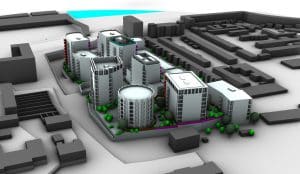Pedestrian Wind Microclimate Assessment
In the heart of East Brighton, the Brighton Gasworks site spans an expansive two hectares, nestled at the crossroads of Marina Way and Roedean Road, just behind Brighton Marina. To the northeast, the majestic South Downs are within easy reach. The current landscape of the site boasts a pair of disused gasholders, complete with the supporting gas infrastructure, as well as unassuming low-rise structures and designated areas for vehicle storage.
Artist’s impression of ‘The Circus’.
Source: https://brightongasworks.co.uk/

One of Windtech’s proposed wind mitigation schemes
Delving into its past, this site was once home to seven gasholders and their infrastructure. However, gas production ceased in 1860, transforming the space into a hub for gas storage and distribution. Fast forward to 2012, and a shift in gas storage methods led to the abandonment of the gasholders. Today, only a tiny portion of the site is necessary for operational purposes, paving the way for exciting redevelopment opportunities.
With a history deeply intertwined with gas, the site does carry a legacy of contamination. Nevertheless, this historical footprint is now set for transformation as part of a comprehensive redevelopment initiative. The goal? To breathe new life into the area, making it suitable for residential and public use while enhancing the surrounding environment.
Windtech Consultants were engaged to carry out an analysis of the wind microclimate surrounding the Proposed Development located at Brighton Gasworks. This wind microclimate assessment is aimed at quantitatively evaluating the impact of the Proposed Development on the wind conditions within and around the site. The Brighton Gasworks site is flanked to the west by a row of terraced houses and is bordered to the south by a spacious car park. In the broader vicinity, the landscape comprises a mix of terraced housing and some high-rise developments, including the eight-story Marine Gate Holdings to the east. All of this context was considered when undertaking a detailed assessment of the wind microclimate.
To conduct this in-depth wind microclimate assessment, Computational Fluid Dynamics (CFD) was used, which quantitatively simulates wind conditions around the site. Results from the simulation were compared with the Lawson Criteria, ensuring pedestrian wind comfort and safety.
If you are working on any projects that could benefit from the capabilities presented in this article, please reach out to our regional offices Sydney & Melbourne, Australia, London, UK, and Mumbai, India. New York & Miami, USA, Toronto, Canada, Dubai, Hong Kong & Singapore, we guarantee to support you wherever you are
based.
To get regular updates on news and events, please follow us on our LinkedIn page.



